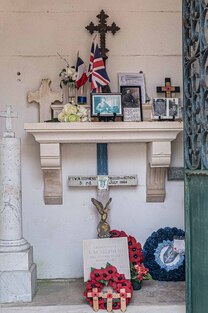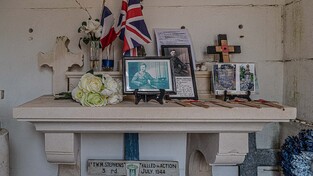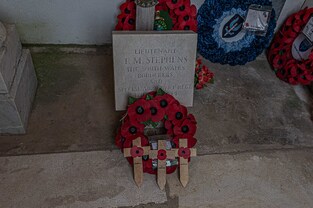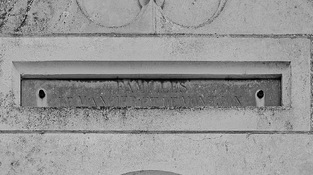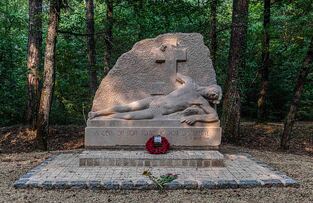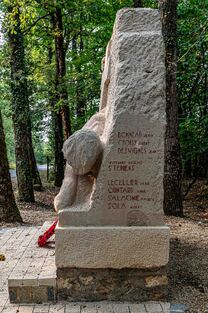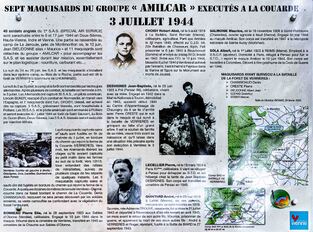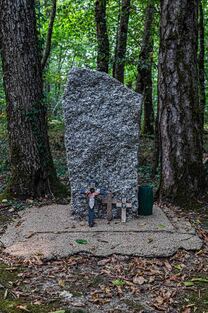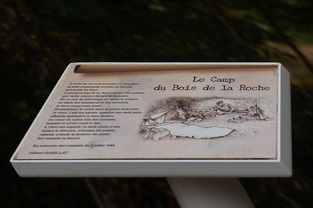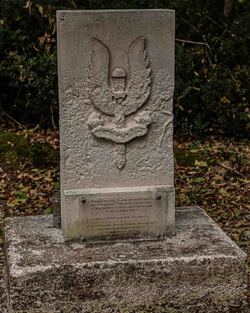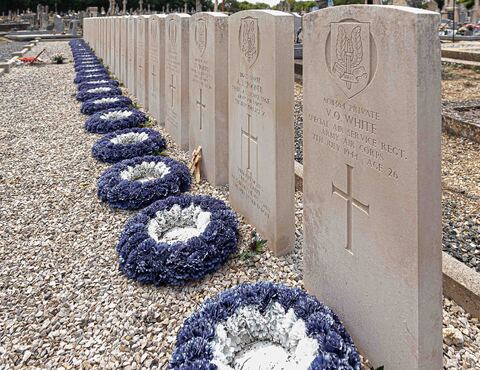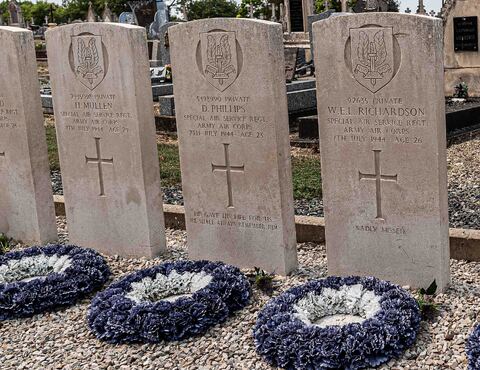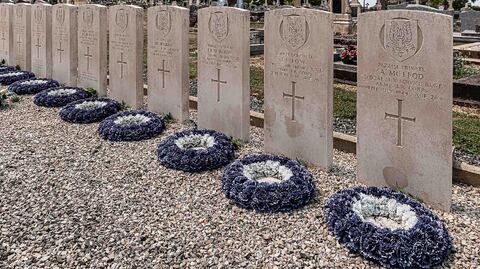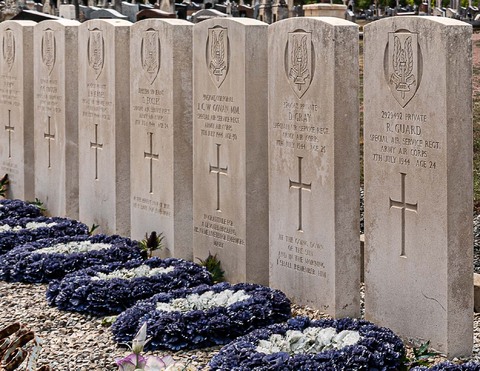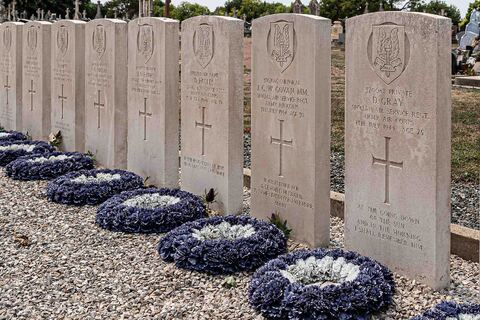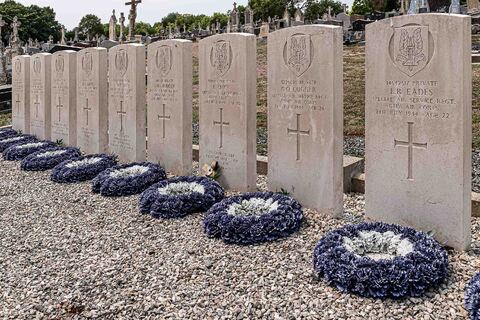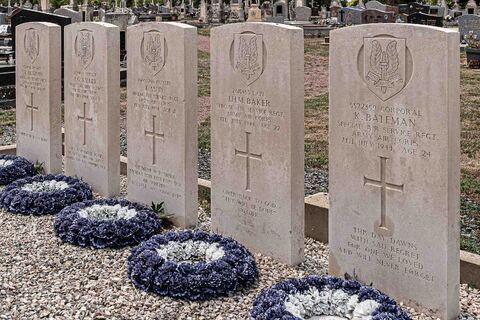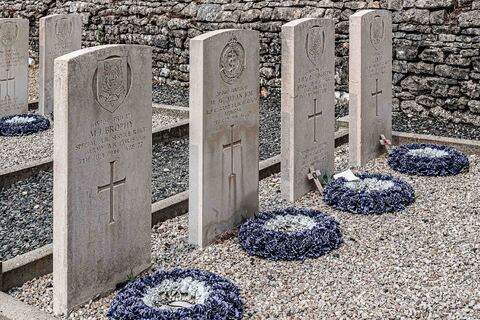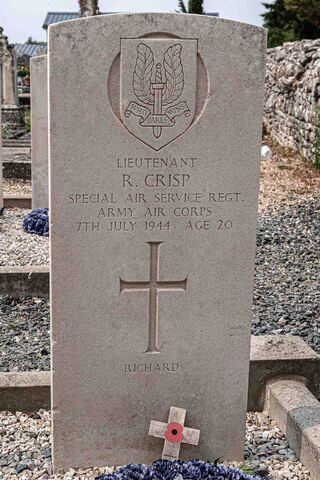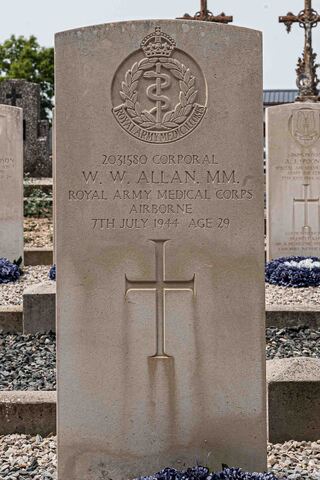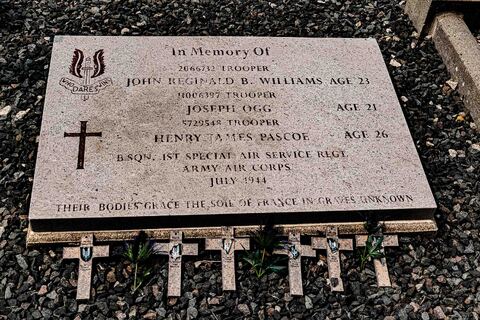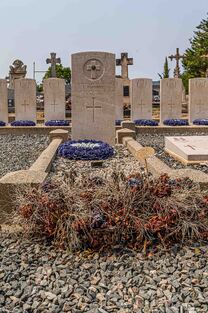- Home
- About The Project
- About The Author
- Latest additions to the project
- Operation BULBASKET
- Oradour-Sur-Glane Massacre 10 June 1944
- British Normandy Memorial
- John Northend - The Inspiration
- Lancaster W4192 "QR-E" 61 Squadron RAF
- The Cemeteries; UK, Ireland and European mini-tour
- Aarestrup Kirke, Denmark
- Aarestrup Kirke - Loss of Liberator KH410
- Aarhus Vestre Cemetery, Denmark
- Arnhem Oosterbeek Cemetery, Holland
- Basingstoke, Wortley Road Cemetery
- Bayeux War Cemetery, France
- Church Of Ireland Churchyard, Belturbet, Republic of Ireland
- Bergen-Op-Zoom, Netherlands
- Bretteville-sur-Laize Canadian War Cemetery
- Brookwood Military Cemeteries
- Cambridge American Cemetery
- Cranwell, St Andrews Parish Church
- D-Day Gold Beach - Remnants of Mulberry Harbour
- Deutsche Soldatenfriedhof, Cannock Chase
- Deutsche Soldatendfriedhof La Cambe, Normandy
- Dunkirk Town Cemetery, France
- Enniskillen Roman Catholic Cemetery
- Escoublac-La Baule War Cemetery St Nazaire
- HAMEL MILITARY CEMETERY, Somme Department, Northern France
- Harefield St Mary's ANZAC Cemetery
- Royal Victoria Hospital Netley and Military Cemetery, Southampton
- Nijmegen Jonkerbos War Cemetery
- Northwood Cemetery
- Odense Assistens Cemetery, Denmark
- Poperinghe New Military Cemetery, Belgium
- Ranville Churchyard, France
- Ration Farm Cemetery, Chapelle D'Armentieres, France
- Reichswald British War Cemetery, Germany
- Runnymede Commonwealth Air Forces Memorial
- Scopwick Burial Ground, Scopwick, Lincolnshire
- Sleaford Cemetery
- Sainte Marè Église
- CWGC Eyes On, Hands On Volunteer Programme
- Biography Flight Sergeant Eleanor Maud Barker WAAF
- Biography Commandant Roger Baudoin French Foreign Legion
- Biography Trooper George Sydney Herbert Biffin B Sqn 1 SAS
- Biography Lance Sergeant Charles Frederick Bristow GM RE
- Biography Lt HD Brotheridge Ox & Bucks Light Infantry
- Biography Lieutenant W H England No 48 RM Commando
- Buffalo LVT 'Conqueror' destroyed at Walcheren.
- Biography Pilot Officer Emil Fechtner RAF (Czech)
- Biography Private Oswald Fisher 2nd RM Bn, RN Division, RMLI 1916
- Biography Lt Col J G Fitzmaurice MC Royal Tank Regiment
- Biography Flight Sergeant Josef František DFM* RAF
- Biography Sergeant Pietro Alfredo Giovetti RAFVR
- Biography Lieutenant John Grayburn VC, 2 Para
- Biography Lt Cdr Nicodeme Guilonard Netherlands Navy
- Biography Major The Viscount Arthur Onslow Edward Guinness, Viscount Elveden.
- Biography Captain PH Haydon DSO No. 41 RM Commando
- Biography Private Owen Hooper, The Buffs & 4 Commando
- Biography Lieutenant Joseph Patrick Kennedy Jr. US Navy
- Biography Flight Lieutenant DSA Lord VC RAF
- Biography Major Robert Reid Maitland MB CHB RAMC
- Biography Wg Cdr Jaroslav Maly RAF
- Biography Lieutenant Colonel William McDowell DSO BSc RE
- Biography Flying Officer Geoff Adrian Mombrun RAFVR
- Biography Marine Byron Moses No. 41 RM Commando
- Biography Flying Officer J E Northend RAFVR
- Biography Group Captain 'Bobby' Oxspring DFC** AFC RAF
- Biography FO Ludwik Witold Paszkiewicz DFC RAF
- Biography Lieutenant HE 'Jimmy' Pearson MC The Reconnaissance Corps
- Biography Rifleman Frank Pennefather, 3rd NZ Rifle Brigade
- Biography Sergeant Robert John "Jack" Preece, 61 Squadron RAF.
- Biography Lieutenant John Richard Priestley The Rifle Brigade
- Biography Staff Sjt Christopher Robinson Glider Pilot Regt., AAC
- Biography Private AMB Roozeboom No 10 (I-A) Cdo
- Biography Sepoy Mahrup (Mahruf) Shah 129th Duke of Connaught's Own Baluchis
- Biography Flying Officer Burrell AT Soundy RNZAF
- Biography Private James Stokes VC 2nd Bn KSLI
- Biography Lieutenant Colonel Leon Robert ‘Bob’ Vance, US Army Air Force
- Taking Chance. The importance of remembrance.
- Useful Links- Museums and Websites
- MA FINAL PROJECT
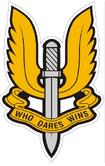
Operation BULBASKET 6 June - 24July 1944
1. Introduction and overview
2. Insertion into France
3. Attack on fuel trains in Châtellerault railway sidings
4. Minelaying Forêt du Défant
5. Moving Campsites
6. Verrières - attack in the woods
7. Execution of Bulbasket men at St Sauvant
8. Reprisal air raid on Bonneuill-Matours
9. Carrying on
10. Order to cease operations , replacement by 3 (French) SAS
11. Extraction
12. Aftermath
13. Graves and Memorials
14. SAS War Crimes Investigation Team
15. Timeline and Achievements
16. Roll of Honour
17. Picture Gallery - Graves of the Op. BULBASKET Soldiers
1. INTRODUCTION and OVERVIEW
Both attackers and defenders knew that the one of the key factors in the success of the invasion of Normandy would be the speed with which the Germans could reinforce Rommel's defences in northern France, particularly with the famed 'Panzer Divisions' of Tiger and Panther tanks.
Operation BULBASKET was deployed to block the Paris - Bordeaux railway to prevent or delay the German Army reinforcing the Normandy defences, particularly to delay the German 2nd SS Panzer Division 'Das Reich' from moving north, by railway (fastest method and easiest supply lines option) or by road (longer transit time, more fuel and supply line dependent).
2. INSERTION
'A' Troop of B Squadron 1st Special Air Service Regiment (A Tp B Sqn 1 SAS) under Captain John Tonkin was parachuted in, commencing on 6th June 1944. Further groups were parachuted in on 8th, 10th and 11th June, with a further drop on 17th June which included RAMC medic Cpl Allan, and the 'trademark' SAS Vickers K-armed Jeeps. This was the first operational airdrop of Jeeps in militry history, using four large parachutes per 'frame', each frame holding one jeep.
3. RAF MOSQUITO ATTACK ON CHÂTELLERAULT RAILWAY SIDINGS
The Operation's early major success was confirming intelligence received on 10th June 1944 of the location of the petrol supply train of the 2nd SS Panzer Division, in railway sidings at Châtellerault. Captain Tonkin explained that "a very frightened and therefore very courageous French civilian" (McCue. 1996:28), thought to be a railway worker, arrived at the SAS base and reported that there were 11 petrol trains in railway sidings about 1000 metres southwest of Châtellerault. As Lt Twm Stephens was a small, dark-haired Welshman with "a dapper moustache", and one of the better French-speakers in the troop, he was deemed most likely to pass off as a Frenchman and so was kitted out with a suit and other civilian clothes. With the railway worker and an enthusiastic Resistance fighter, Lt Stephens conducted a recce of some 120 kms by bicycle to confirm the intelligence but reported that the target was too well defended for B Squadron to attack it, therefore the information was passed back for the RAF to destroy the target by precision bombing.
No 140 Wing RAF, at RAF Gravesend, was immediately tasked to provide 6 aircraft for an immediate low-level attack mission, and simultaneously No 138 Wing, RAF Lasham, was tasked to provide a further 6 aircraft for a second attack shortly afterwards. These wings were undoubtedly selected as they had become experts in low-level precision bombing raids; in particular, No 140 Wing had conducted the famous raid on Amiens precision in which hundreds of Resistance fighters, all under imminent sentence of death, were freed when Mosquitos bombed and breached the prison walls enabling the prisoners to escape. No 138 Wing RAF provided aircraft from No 107 Sqn RAF, and No 140 Wing provided 3 aircraft each from 464 Squadron Royal Australian Air Force and 487 Squadron Royal New Zealand Air Force.
The aircraft were the very potent Mosquito Mark FB Mark (Mk) VI fighter bombers, each capable of carrying 4 x 250lb bombs and armed with 4 x .303" Browning machine guns and 4 x 20mm Hispano cannon mounted in the nose of the aircraft. The Mosquito was a remarkable aircraft, known as 'the Wooden Wonder' as it was built of wood, and designed 'on spec' by the de Havilland company, not for an extant Air Ministry requirement / specification. It was faster than any German fighter at the time, and initial variants were unarmed, relying on superior speed to escape from the enemy. In this aspect de Havillands were continuing the ethos employed in WW1 with the DH4 bomber, which was also faster than the contemporary German fighters.
Several variants of the Mosquito were developed, including night fighters, bombers, maritime strike aircraft, photo-reconnaissance aircraft, and of course the famous fighter bomber variants. such as the FB Mk VI used at Châtellerault.
That night, 11th June 1944, the Mosquito Mark FB VIs attacked and destroyed the trains in the railway sidings.
THE OPERATIONS RECORD BOOK (SUMMARY OF EVENTS) for No 107 Sqn at RAF Lasham records the following for 11 June 1944:
No. 138 Wing Airfield,
Lasham, Hants.
11/6/44. WEATHER: - Warm front during the day - improving later at night.
OPERATIONAL FLYING. The following aircraft and crews carried out a low level
attack deep into France in the late evening. The target was 7 PETROL AND OIL TRAINS in the
MARSHALLING YARDS AT CHÂTTELLERAULT:-
A/C Details
|
Code |
Serial |
Pilot |
Navigator |
|
P. |
NS. 820. |
W/CDR. POLLARD. |
F/O. DRUMMOND. |
|
G. |
NS. 852. |
F/LT. SLIP. |
F/O. THOMAS. |
|
C. |
NS. 912. |
S/LDR. BRITTAIN. |
F/O. STEPHENSON. * |
|
* (The details given in the detailed record show aircraft 'J' HJ. 771.) |
|||
|
B. |
NT. 207. |
F/LT. WHITTLE. |
F/O. SHANAHAN. |
|
R. |
NT. 136. |
W/O. MARTIN. |
F/S. PATTERSON |
|
Q. |
NS. 886. |
F/S ROSS. |
F/O. GREEN. |
Note: Pilot of NT316, W/O Martin was Canadian, and pilot of NS886, F/Sgt Ross, was Australian.
OPERATIONAL FLYING. When the aircraft reached the target area it was already dark,
but the target was well alight as a result of the good work of another Mosquito attack
delivered earlier. All the aircraft bombed and the fires were considerably increased.
When the last of the six aircraft left, the Wing Commander delivered a cannon attack along
the whole length of the Marshalling Yards. Immense oil fires were left burning.
All the aircraft returned safely to base by 00.30 hours, having been airborne for 3 hrs. 20 minutes.
The Squadron's Operations Record Book (Detail of Work Carried Out) records the following narrative.
PETROLEUM TANKERS IN MARSHALLING YARDS
AT CHÂTELLERAULT
---------------------------------------------------------
In resonse to a sudden call from the Army, W/CDR POLLARD led a formation of six aircraft in an attack on a large concentration of petroleum wagons in the Marshalling Yards at CHÂTELLERAULT.
Weather over England and France was cloudy and the formation was obliged to fly at 6000' above 10/10ths cloud for a considerable time.
The cloud began to break when the aircraft had penetrated 80 miles in to France and so the formation descended to ground level for the remainder of the journey.
On approachingthe target area the a/c climbed to 3000'.
Dusk was gathering as a dive attack was carried out.
The a/c bombed at intervals of about one minute under direction from W/CDR. POLLARD.
Large fires were started by the fire of cannon as well as by the bomb bursts.
The a/c proceeded to BASE independently.
No oposition was encoutered anywhere on route. All a/c reached BASE safely although J - JCG developed
trouble in the port motor.
S/LDR. BRITTAIN made a successful landing, having feathered the port airscrew.
4. Minelaying Forêt du Défant
5. Moving Campsites
6. ATTACK ON VERRIÈRES CAMP
On the night of 3/4 July 1944, the SAS camp was attacked by the German Army; different theories pertain as to how the Germans became aware of the location of the SAS harbour area (camp). Two SAS NCOs, Sergeant Eccles and Corporal Bateman had been captured on the night of 28th June in the process of conducting a sabotage operation. The two NCOs were interrogated, but resisted giving information for at last 48 hours to give their colleagues time to enact the standard protocol and relocate the SAS camp; however finding a camp with an adequate water supply for the party proved very difficult, so when the Germans appeared not have extracted the knowledge of the camp from their comrades, the SAS detachment returned to Verrieres temporarily on 2 July, while a better site was sought.
Another theory is that local collaborators had discovered its whereabouts and passed the information to the German SS Security Police.
A force of several hundred German troops centred around the 17th SS Panzergrenadier Division "Goetz von Berlichingen" attacked the SAS camp, at dawn on 3rd July. Trooper John Fielding, formerly member of a Norwich Auxiliary Units patrol, had been concerned about a Frenchman who had approached the camp, who was supposedly a Maquisard from another Resistance group. Although Trooper FIelding was highly suspicious, the Frenchman's identity was confirmed and he was released before the attack. But John Fielding always regretted not having shot him. Had the Frenchman been conducting a recce to confirm the presence of the SAS detachment in the camp? The Germans attacked and although they fought back, the SAS men realised that they were heavily outnumbered and needed to break out. Captain Tonkin stayed behind and set 'time pencil' explosives in the abandoned supplies before trying to escape. These explosives detonated later and are believed to have killed a number of German troops.
A party of SAS men, French Maquisards and an American pilot, led by Lt Tomos Stephens, attempted to break out but were ambushed on a forest track in the Foret du Verrieres. Lt Stephens was wounded and subsequently beaten to death with a rifle butt by a German Officer; the 7 Maquisards were summarily executed. (Author Paul McCue suggests that Lt Stephens may also have been shot with the 7 Maquisards.)
The remaining men, and US Army Air Force P51 pilot 2nd Lt Lincoln Delmar Bundy, were taken prisoner and taken to the same prison as Sgt Bateman and Cpl Eccles. On 7th July, they were all taken to the woods near St. Sauvant, and executed by firing squad commanded by Oberleutnant Vogt, who had been in command of the bicycle-mounted reconnaissance squadron in the Foret du Verrières, under the infamous 'Kommando Befehl', which was also illegal under the accepted international laws of armed conflict.
There is some dispute over whether the SAS men tried to persuade the Germans that Cpl Allan, as a medic, and / or 2nd Lt Bundy as an airman, were therefore not subject to the 'Kommando Befehl' and should not be executed, but to no avail. Unfortunately Bundy was wearing civilian clothes and was adjudged to have joined the SAS operation as a combatant and therefore would have been considered as coming under the terms of the Kommando Befehl, as a commando or paratroop saboteur operating behind the lines, and was executed with the SAS soldiers.Their bodies were then buried in three graves dug the day before by Vogt's troops.
Most unusually, Bundy's body was not consolidated with other American casualties after the war and remains buried with the SAS men with whom he died; possibly because he was buried in a communal grave containing 26 of the fallen troops.
Three wounded SAS men who had been taken prisoner and hospitalised, Troopers Ogg, Pascoe, and Williams, are understood to have been taken from hospital and murdered by lethal injection. They were buried in an unmarked grave and their bodies have never been located.The German Army medical officer later claimed that it was an act of mercy as all three would have died of their wounds.
The uncaptured survivors of the SAS detachment regrouped at their pre-arranged rendevous point and continued with their mission until being ordered home.
7. Execution of Bulbasket men at St Sauvant
8. REPRISAL RAID on the CHÂTEAU de MARIEVILLE at BONNEUILL- MATOURS 14 July 1944
In conjunction with the survivors of B Sqn 1SAS, the Operation JEDBURGH team 'Hugh' which was conducting operations to the East of the Op BULBASKET area of Ops, reported these events back to Special Forces HQ in England. They identified the barracks at the Château de Marieville at Bonneuil-Matours as the HQ of the 17th SS Panzergrenadier Division that had murdered the SAS soldiers, and requested that a reprisal attack be mounted against the HQ.
SAS Brigade HQ liaised with No 2 Group (2 Gp) RAF, of the RAF 2nd Tactical Air Force, and Air Vice Marshal (AVM) Basil Embry, Air Officer Commanding 2 Gp, ordered 140 Wing RAF, which particpated in the raid on the railway sidings at Châtellerault, to conduct the raid. On 14 July 1944 he personally briefed the 14 aircrews from 464 Sqn RAAF, 487 Sqn RNZAF and 21 Sqn RAF at RAF Thorney Island, where 140 Wing had moved shortly after the successful raid on the fuel tanker train in the Châtellerault railway sidings. 464 and 487 Sqns had taken part in the raid at Chatellerault. AVM Embry particularly briefed the crews to 'let the bastards burn', but if shot down, to never mention the aspect of reprisal lest it provoked the Germans into tit-for-tat reprisals with the immortal words:
"if you get shot down and taken prisoner, don't shoot your mouth off about retaliation. You can't out-piss a skunk!'
(McCue. 1996:162)
AVM Embry earned the greatest respect and admiration of his aircrews, as although he was an AVM, he continued flying on operations to evaluate the capabilities, strengths and weaknesses of the aircraft his aircrews were using; he usually flew under the nom de guerre "Wing Commander Smith" in case he was shot down and captured, and usually flew as a wingman in the formation. However his frank and honest reports to the Air Ministry won him few friends in the Ministry. Embry was the driving force behind 2 Gp being equipped with the Mosquito FB VI, and under his command No 2 Gp had become one of the most accurate and efficient units within the whole allied air forces.
The raid on Château de Marieville was in four phases;
- four Mosquitos would drop high explosive bombs;
- six Mosquitos would drop US AN-M76 Napalm-filled incendiary bombs;
- the remaining four Mosquitos would drop more HE bombs;
- finally the aircraft would return to strafe the target before returning to base.
487 Sqn RNZAF's Operations Record Book records that:
"a welcome change of tactics took place when 6 of our aircraft (including G/C. P.G. WYKEHAM BARNES) together with 8 others from 21 and 464 Squadrons took off in daylight to attack Gestapo Headquarters at BONNEUILL MATOURS".
The Mosquitos left Thorney Island at about 21:00 hours UK Local time, and rendezvoused with an escort of 12 Mustang MK III long-range fighter escort aircraft for the very hazardous low level evening 'daylight' crossing of enemy-held territory in Northern France. The force reached the target at approximately 21:00 local time, when the German troops were eating their evening meal. The attack went as planned and all seven barrack blocks were destroyed; local estimates of the number of German troops killed varied from 80 to 200. All aircraft safely returned to Thorney Island in the early hours of 15 July. A further attack followed on the German HQ at Poitiers, using intelligence supplied by the men of A Tp B Sqn 1SAS.
Four aircraft from 464 Sqn RAAF participated in the raid, incorrectly described as "a special target - Gestapo sleeping quarters was attacked at BONNEUILL-MATOURS', piloted by W/Cdr Panitz OC 464 Sqn - who earlier in the day had received his DFC from HM The King at Hartford Bridge - and S/Ldr Hyem, F/Lt Parsons and F/O Walton. 464's ORB lists the aircraft and crews as:
|
Mosquito (FB) VI |
Pilot |
Navigator |
|
HR187 |
S/Ldr R W Hyem (Australian) |
F/O E J Brayne (Australian) |
|
HX919 |
F/O J R C Walton |
F/O C H Harper (Australian) |
|
NS994 |
W/Cdr G Panitz (Australian) |
F/Lt R S Williams (Australian) |
|
NS926 |
F/Lt W D Parsons |
F/O E Ramsay (New Zealand) |
The Squadron's ORB records that "the majority of the bombs fell in the targert area - buidlings seen enveloped in flames and believed target well hit.' The ORB also reported that W/Cdr Panitz and S/Ldr Hyem both attacked trains on the flight back to base, both reporting good strikes on the targets.
487 Sqn's ORB also records that "the attack was a success, the buildings being heavily hit and left in flames. All the aircraft returned safely."
The ORB for 21 Sqn RAF records the following details:
A/C Details
|
Mosquito (FB) VI |
Pilot |
Navigator |
Up |
Down |
|
NT174 |
W/C D F Dennis |
F/O R J Grantham |
20.55 |
00.35 |
|
NT124 |
F/O B Fielding-Johnson |
F/L J Blyth |
20.55 |
00.45 |
|
NT197 |
S/L J Murray |
F/L G S Bliss |
20.55 |
00.25 |
|
LR291 |
F/L D Bell-Irving |
F/O A Holt |
20.52 |
00.35 |
"Part of an attacking force of 14 aircraft detailed to attack Gestapo sleeping quarters, Bonnsuil Mateurs (sic).
Majority of bombs in target area with stray bombs seen to overshoot towards village and one or two on E. bank of river.
Buildings seen enveloped in flames and target believed well hit."
9. Carrying on
10. Order to cease operations , replacement by 3 (French) SAS
11. Extraction
12. AFTERMATH
After the area had been liberated, forest workers discovered areas of disturbed earth and broken branches in December 1944, whilst working in the forest near St Sauvant. Examination of the site revealed human remains so the local police were duly informed. On 18th December the site was excavated and several bodies of soldiers wearing British uniforms were discovered. The Germans had attempted to conceal the identities of the men by removing their identity tags, but two bodies were discovered with their tags intact thus confirming their identity as members of the SAS team; a battle dress blouse marked with the owner's name provided further confirmation, and a body in civilian clothes was confirmed to be that of 2nd Lt Bundy USAAF.
The 31 bodies were buried in Rom village cemetery, with full military honours. The three men from the hospital were never located but are commemorated by a plaque next to the graves of their SAS comrades in Rom cemetery.
Lt Tomos Stephens' body was found by locals on 3rd/4th July 1944 and was interred in the vault of two local families, the Mangier and De Montjon families, in Verrières Communal Cemetery.
A number of German officers were tried for this War Crime after extensive investigations, and were convicted in 1947, but were all released by 1952. The officer who insisted Hitler’s order be carried out by the local forces was never even tried.
13. Graves and Memorials (see photographs section)
Verrières Communal Cemetery. Lt Tomos Mansell Stephens is buried in the family crypt / vault of the Mangier and de Montjon families.
Forêt de Verrières. Memorial to the SAS Troops and the French Resistance fighters at La Couarde. Includes marker stones where the bodies were found. Also there are memorial markers at the entrance to the track leading into the woods where the campsite was set up, and a marker close by the actual campsite location. (The actual campsite location is on private land).
Rom Communal Cemetery. The graves of 30 SAS troops of A Tp, B Sqn 1 SAS and 2nd Lt LD Bundy USAAF are buried in the cemetery at Rom.
Forêt de Saint Sauvant. There is a memorial stone with the names of the SAS troops inscribed on it. There are also markers in the woods where the 3 mass graves were found.
13. Graves and Memorials
14. SAS War Crimes Investigation Team
15. ACHIEVEMENTS AND TIMELINE OF OP BULBASKET
In an analysis of the achievements of Operation Bulbasket, the author Paul McCue lists the following:
- The initiation of four air attacks and a possible fifth, killing upwards of 150 German troops and an unknown number of Milice. Responsibility for the destruction of crucial petrol stocks, delaying the progress of the 2nd Panzer Division towards the Normandy landing area
- The delay of the 226th Infantry Division from Bayonne.
- The delay of the 227th Infantry Division from Carcassonne.
- Execution of 23 successful road and rail sabotage operations
Operation Bulbasket: Timeline
- 1 June 1944; Two officers of 'B' Squadron, 1st Special Air Service, Captain John Tonkin (OC) and Second Lieutenant Richard Crisp (2IC), were briefed on the operation by SHAEF in London
- 6 June; Their drop zone was an area of the Brenne marsh 19 miles (31 km) south west of Châteauroux, which they reached at 01:37 hours
- 7 June; further group from 'B' Squadron were parachuted in
- 9/10 June; move to 'Sazas' farm south of Montmorillon
- 11 June; further group from 'B' Squadron were parachuted in
- 10/11 June; location of petrol train confirmed. Tonkin contacted England and requested an air attack. A force of 12 de Havilland Mosquito fighter-bombers of No. 464 Sqn. RAAF, No. 487 Sqn. RNZAF, and No. 107 Sqn. RAF attacked the trains in the railway sidings. The mission was a success, destroying the fuel reserves for the 2nd SS Panzer Division Das Reich.
- 12/13 June; Lieutenant Crisp, one of those later executed, was in command of a patrol that laid mines on the N147 in the Forêt du Défant, just before the 2nd SS Panzer Division arrived in the area.
- 13 June; move to Nerignac
- 19 June; move to Pouillac
- 21 June; move to Persac
- 25 June 1944; The SAS Squadron move to Verrières.
- 1 July; move to a new camp just south in the Bois des Cartes. Water supply failed.
- 2 July; return to Verrieres. The force in the forest camp consisted of 40 SAS men, a P-51 Mustang pilot, Second Lieutenant Lincoln Bundy and nine men from the French Resistance.
- 3/4 July: German attack on Verrieres
- 5 July; survivors move to Foret de Plessac
- 6/7 July; men executed at St Sauvant
- 9 July; move to Charroux
- 14 July; move to Asnieres sur Blour or Forêt de Défant
- Subsequently, near Luchapt, Tonkin and the remainder of the Squadron (altogether eight survivors of the attack and three others), regrouped and carried on with the mission
- 24 July 1944; order to cease operations was received
- 28 July; move to north of Montmorillon
- 6/7 August; survivors extracted
Bibliography:
McCUE, Paul. 1996. Operation Bulbasket. Pen and Sword: Barnsley.
16. ROLL OF HONOUR - OPERATION BULBASKET
|
MURDERED 3RD JULY 1944. AFTER BEING WOUNDED, WAS BEATEN TO DEATH BY A GERMAN OFFICER. VERRIÈRES FOREST. BURIED IN VERRIÈRES COMMUNAL CEMETERY, VERRIÈRES, VIENNE |
||||||
|
Rank |
Forename |
Surname |
Decorations |
Age |
Unit |
|
|
Lieutenant |
TOMOS MANSEL |
STEPHENS |
M.I.D. |
24 |
A Tp B Sqn 1 SAS Regt AAC |
|
|
DIED 7TH JULY 1944. Executed by firing squad by the Recce Sqn of the local German Division. BURIED IN ROM COMMUNAL CEMETERY, DEUX-SEVRES |
|
|||||
|
Rank |
Forename |
Surname |
Decorations |
Age |
Unit |
|
|
2nd Lieutenant |
LINCOLN DELMAR |
BUNDY |
|
26 |
486th Fighter Sqn US Army Air Force |
|
|
Lieutenant |
RICHARD |
CRISP |
|
20 |
A Tp B Sqn 1 SAS Regt AAC |
|
|
Serjeant |
DOUGLAS |
ECCLES |
|
24 |
A Tp B Sqn 1 SAS Regt AAC |
|
|
Serjeant |
ROBERT ERIC |
HEAVENS |
|
31 |
A Tp B Sqn 1 SAS Regt AAC |
|
|
Lance Serjeant |
JOHN RUSSELL |
JESSIMAN |
|
23 |
A Tp B Sqn 1 SAS Regt AAC |
|
|
Corporal |
WILLIAM WATT |
ALLAN |
Military Medal (Posthumous) |
29 |
Royal Army Medical Corps att A Tp B Sqn 1 SAS Regt AAC |
|
|
Corporal |
JOHN |
KINNIVANE |
|
26 |
A Tp B Sqn 1 SAS Regt AAC |
|
|
Corporal |
KENNETH |
BATEMAN |
|
24 |
A Tp B Sqn 1 SAS Regt AAC |
|
|
Corporal |
REGINALD |
CHICK |
|
23 |
A Tp B Sqn 1 SAS Regt AAC |
|
|
Corporal |
JAMES CHISHOLM WILSON |
GOVAN |
Military Medal (1940, RASC) |
30 |
A Tp B Sqn 1 SAS Regt AAC |
|
|
Corporal |
LESLIE CHARLES |
LONG |
|
26 |
A Tp B Sqn 1 SAS Regt AAC |
|
|
Lance Corporal |
JAMES HENRY MALCOLM |
BAKER |
|
22 |
A Tp B Sqn 1 SAS Regt AAC |
|
|
Trooper |
ALEXANDER |
McLEOD |
|
26 |
A Tp B Sqn 1 SAS Regt AAC |
|
|
Trooper |
EDWARD YOUNG |
ADAMSON |
|
22 |
A Tp B Sqn 1 SAS Regt AAC |
|
|
Trooper |
ALAN GEORGE |
ASHLEY |
|
24 |
A Tp B Sqn 1 SAS Regt AAC |
|
|
Trooper |
JAMES |
ASPIN |
|
21 |
A Tp B Sqn 1 SAS Regt AAC |
|
|
Trooper |
DAVID |
GRAY |
|
25 |
A Tp B Sqn 1 SAS Regt AAC |
|
|
Trooper |
DONALD MACPHAIL |
LIVINGSTONE |
|
29 |
A Tp B Sqn 1 SAS Regt AAC |
|
|
Trooper |
HENRY |
MULLEN |
|
29 |
A Tp B Sqn 1 SAS Regt AAC |
|
|
Trooper |
DONALD |
PHILLIPS |
|
23 |
A Tp B Sqn 1 SAS Regt AAC |
|
|
Trooper |
WILLIAM ERNEST LIDDELL |
RICHARDSON |
|
26 |
A Tp B Sqn 1 SAS Regt AAC |
|
|
Trooper |
SIDNEY JACK |
RYLAND |
|
29 |
A Tp B Sqn 1 SAS Regt AAC |
|
|
Trooper |
ERIC GEORGE |
SIMMONS |
|
26 |
A Tp B Sqn 1 SAS Regt AAC |
|
|
Trooper |
ANTHONY JOHN |
SPOONER |
|
20 |
A Tp B Sqn 1 SAS Regt AAC |
|
|
Trooper |
VICTOR OWEN |
WHITE |
|
26 |
A Tp B Sqn 1 SAS Regt AAC |
|
|
Trooper |
GORDON HUBERT FRANK |
BUDDEN |
|
21 |
A Tp B Sqn 1 SAS Regt AAC |
|
|
Trooper |
HARRY |
HILL |
|
29 |
A Tp B Sqn 1 SAS Regt AAC |
|
|
Trooper |
MICHAEL JOSEPH |
BROPHY |
|
22 |
A Tp B Sqn 1 SAS Regt AAC |
|
|
Trooper |
GEORGE OLIVER |
COGGER |
|
24 |
A Tp B Sqn 1 SAS Regt AAC |
|
|
Trooper |
LESLIE RONALD |
EADES |
|
22 |
A Tp B Sqn 1 SAS Regt AAC |
|
|
Trooper |
RONALD |
GUARD |
|
24 |
A Tp B Sqn 1 SAS Regt AAC |
|
|
BELIEVED TO HAVE DIED c13th JULY 1944. Murdered by lethal injection by a German Army doctor. NO KNOWN GRAVES, COMMEMORATED WITH THEIR COLLEAGUES AT ROM COMMUNAL CEMETERY, ROM, DEUX-SEVRES |
|
|||||
|
Rank |
Forename |
Surname |
Decorations |
Age |
Unit |
|
|
Trooper |
JOHN REGINALD B. |
WILLIAMS |
|
23 |
A Tp B Sqn 1 SAS Regt AAC |
|
|
Trooper |
JOSEPH |
OGG |
|
21 |
A Tp B Sqn 1 SAS Regt AAC |
|
|
Trooper |
HENRY JAMES |
PASCOE |
|
26 |
A Tp B Sqn 1 SAS Regt AAC |
|
FRENCH RESISTANCE FIGHTERS
SUMMARILY EXECUTED 3RD JULY 1944. AFTER BEING CAPTURED IN VERRIÈRES FOREST.
|
Name |
Notes |
|
Pierre Lecellier |
Initially buried in the Verrières cemetery, his body was transferred in 1945 to the Persac cemetery where it has rested ever since |
|
Jean Desvignes |
His name is inscribed on the monument to the dead of Persac as well as on the memorial of La Couarde in Verrières |
|
Albert Sola |
Initially buried in the Verrières cemetery, his body was transferred on June 27, 1947 to the old Colombes cemetery in the family vault |
|
Andre Quintard |
His name is inscribed next to that of his brother Roger on the monument to the dead of Neuville-de-Poitou. It also appears on the memorial of La Couarde in Verrières. |
|
Pierre Bonneau |
First buried in the Verrières cemetery, his body was transferred in 1945 to the cemetery of La Chaume, in Les Sables-d'Olonne |
|
Albert Choisy |
Known as Albert, his actual name was Robert. He was shot in the head during the fighting on 3rd July at Verrières. He was buried in the cemetery at Joussé, Vienne, where he was born. |
|
Maurice Salmoni. |
His family having never asked for the return of his body, he was transferred (from Verrières?) in 1947 and buried at the national necropolis of Sainte-Anne-d'Auray (Morbihan) |
Rest in peace brave warriors.
17. Picture Gallery - Graves of the Op. BULBASKET Soldiers
Verrières Communal Cemetery
Click on the photographs - many of the photographs have extra information attached to them, which is only accessible by clicking on the photographs!
The final resting place of Lt Tomos Stephens in the family vault of the Mangier and de Montjon familes in Verrières Communal Cemetery at Verrières, Vienne, Nouvelle-Aquitaine.
Rom Communal Cemetery
The graves of the 30 officers and men of A Troop, B Squadron, 1st Special Air Service Regiment murdered by the Germans at La Couarde, Forêt de Verrières, la Vienne, on 7th July 1944.
Credit ; https://www.specialforcesroh.com/index.php?media/operation-bulbasket-grave-site.34997/
Click on the photographs - many of the photographs have extra information attached to them, which is only accessible by clicking on the photographs!
The headstone of 2nd Lt LD Bundy USAAF; to the right of the headstone is the plaque commemorating the three wounded SAS Trooopers murdered by lethal injection after being removed from hospital. Adjacent are the headstones of 30 members of the SAS Bulbasket team of A Troop, B Squadron 1 SAS Regiment, including the RAMC medic Cpl Allan MM, all murdered / executed by firing squad on 7 July 1944.
2nd Lt Lincoln D Bundy.
Hit by flak in his Mustang and crashed near La Maillerave on 10 Jun 1944. Made his way south 300 km, found by a friendly French family who passed him on to the Maquis, he was then passed to the British SAS to arrange his escape. He, together with the SAS were discovered by the Germans and all were executed. In December 1944 the mass grave was discovered in the Bois de Guron, South-west of Poitiers. All bodies were exhumed, and reburied with full military honours, on 23 December 1944, in the village graveyard of Rom, France.
(source: )
The curious story of 5727819 Trooper George Sydney Herbert Biffin A Tp, B Sqn, 1 SAS, who came back to life!
See https://tellthemofus.uk/biography-trooper-biffin
